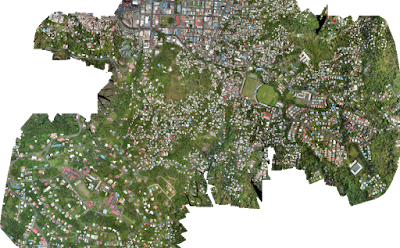A New View of Disaster Risk and Reduction: An Interview with Roger Pulwarty, Senior Scientist at NOAA. The UN Office for Disaster Risk Reduction recently released the fifth edition of the Global Assessment Report on Disaster Risk Reduction (GAR19). The report highlights the increasingly complex interaction between hazards, and provides an update on how risk and risk reduction are understood in practice. GAR19 also highlights how the latest Disaster Risk Reduction (DRR) framework integrates into global goals such as the Paris Agreement and the 2030 Agenda for Sustainable Development. To better understand the scope and significance of this report, New Security Beat sat down with Roger Pulwarty, Senior Scientist at NOAA, and a lead author of the GAR19... Read more.
A New View of Disaster Risk and Reduction: An Interview with Roger Pulwarty, Senior Scientist at NOAA. The UN Office for Disaster Risk Reduction recently released the fifth edition of the Global Assessment Report on Disaster Risk Reduction (GAR19). The report highlights the increasingly complex interaction between hazards, and provides an update on how risk and risk reduction are understood in practice. GAR19 also highlights how the latest Disaster Risk Reduction (DRR) framework integrates into global goals such as the Paris Agreement and the 2030 Agenda for Sustainable Development. To better understand the scope and significance of this report, New Security Beat sat down with Roger Pulwarty, Senior Scientist at NOAA, and a lead author of the GAR19... Read more.
Countries need to understand risk better for climate adaptation and resilience, says GFCS Head. Understanding of hazards, frequency, intensity and potential impacts is crucial for preparedness and long term development plans,” said the GFCS Director... Read more.
Interesting Facts
Global Assessment Report on Disaster Risk Reduction (GAR19). Every two years, the UN Office for Disaster Risk Reduction (UNDRR) works with thinkers, practitioners, experts and innovators to investigate the state of risk across the globe: highlighting what’s new, spotting emerging trends, revealing disturbing patterns, examining behaviour, and presenting progress in reducing risk. The findings make up the 2019 Global Assessment Report on Disaster Risk Reduction (GAR2019)... Read more.
AI Competition for Disaster Response in the Caribbean Is Live. Azavea partnered with the World Bank and WeRobotics to create a dataset of aerial drone imagery of buildings across the Caribbean annotated with characteristics that matter to building inspectors. Many parts of the Caribbean contain houses and buildings that are not up to modern construction standards. Residents of these areas are especially vulnerable to risk from natural disasters... Read more.
Policy Developments and Outlook
Managing climate and disaster risk in fragile states. It is encouraging to see that over the last few years the political mood has shifted. Countries such as Sweden, Germany, UK and Netherlands are actively investing in studies and programmes that look at the impact of climate change and disaster in conflict affected states. The Global Assessment Report 2019 (GAR19) also has section on the need to increase investments in addressing climate change and disaster risk in fragile countries. Failure to do so is entirely compromising the global ambition to achieve the Sendai Framework, and especially Target E, which we need to hit by 2020. This growing consensus will hopefully drive more research on the impact that DRR and climate change adaption have on conflict prevention... Read more.
Strengthening Climate Risk Finance in the Caribbean for Rapid Assistance in Emergencies. WFP’s Caribbean Risk Financing Strategy aims to ensure that the most vulnerable populations in the Caribbean are better protected through social protection systems that are more shock-responsive due to predictable, rapid and flexible financing... Read more.
How big data assists in disaster relief and preparedness. Historically, public policies have proved ineffective in providing adequate help for disaster-stricken citizens. A year after hurricane Harvey in 2017, for example, residents are still in the midst of recovery despite $15.3 billion earmarked for relief efforts. With the emergence of new innovations, one wonders if legislators should give more thought to incorporating Big Data technologies into aiding in disaster prediction and relief... Read more.
Policy Developments and Outlook
Managing climate and disaster risk in fragile states. It is encouraging to see that over the last few years the political mood has shifted. Countries such as Sweden, Germany, UK and Netherlands are actively investing in studies and programmes that look at the impact of climate change and disaster in conflict affected states. The Global Assessment Report 2019 (GAR19) also has section on the need to increase investments in addressing climate change and disaster risk in fragile countries. Failure to do so is entirely compromising the global ambition to achieve the Sendai Framework, and especially Target E, which we need to hit by 2020. This growing consensus will hopefully drive more research on the impact that DRR and climate change adaption have on conflict prevention... Read more.
Strengthening Climate Risk Finance in the Caribbean for Rapid Assistance in Emergencies. WFP’s Caribbean Risk Financing Strategy aims to ensure that the most vulnerable populations in the Caribbean are better protected through social protection systems that are more shock-responsive due to predictable, rapid and flexible financing... Read more.
How big data assists in disaster relief and preparedness. Historically, public policies have proved ineffective in providing adequate help for disaster-stricken citizens. A year after hurricane Harvey in 2017, for example, residents are still in the midst of recovery despite $15.3 billion earmarked for relief efforts. With the emergence of new innovations, one wonders if legislators should give more thought to incorporating Big Data technologies into aiding in disaster prediction and relief... Read more.



